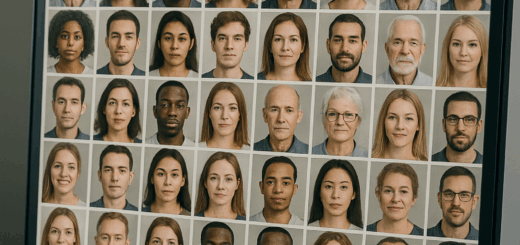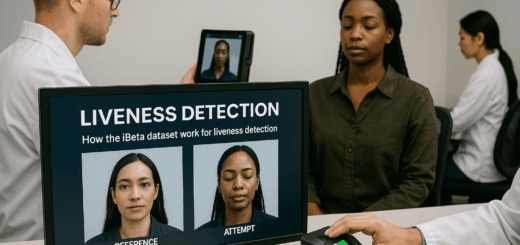What Is iBeta Level 3 Dataset?
The iBeta Level 3 dataset represents the highest tier of Presentation Attack Detection (PAD) testing envisioned under the ISO/IEC 30107-3 standard. While Level 1 and Level 2 focus on resisting basic and advanced spoofing attacks, Level 3 takes it a step further by simulating state-of-the-art, resource-intensive attacks that reflect the most challenging threats in biometric security.
Although fewer vendors attempt Level 3 testing due to its difficulty, it is increasingly relevant as attackers gain access to AI-driven deepfakes, advanced 3D printing, and synthetic biometrics.

1. Purpose of the iBeta Level 3 Dataset
The Level 3 dataset is designed to:
- Simulate highly sophisticated presentation attacks that only skilled adversaries could execute.
- Validate next-generation liveness detection technologies.
- Provide assurance for ultra-secure environments such as defense, border control, and critical infrastructure.
- Push biometric systems beyond commercial-grade resistance, ensuring they can withstand future spoofing methods.
2. Composition of the Level 3 Dataset
The dataset includes both genuine samples and extremely advanced spoof artifacts:
- Genuine Biometric Samples
- Gathered from diverse volunteers under strict lab supervision.
- Used to verify that the system still accepts legitimate users reliably.
- Gathered from diverse volunteers under strict lab supervision.
- Level 3 Spoof Samples
- Created using specialized equipment, advanced manufacturing, and AI techniques.
- Spoof budget: typically greater than Level 2 (though constrained for fairness, e.g., ≤ USD 1000).
- Examples include:
- Hyper-realistic 3D masks made from resin, silicone composites, or prosthetics.
- AI-generated deepfakes for facial and voice recognition.
- Multispectral spoof attempts simulating skin depth and heat signatures.
- Synthetic biometric data generated through machine learning.
- Hyper-realistic 3D masks made from resin, silicone composites, or prosthetics.
- Created using specialized equipment, advanced manufacturing, and AI techniques.
3. Testing Parameters
- Number of Subjects: A larger sample group, often 8–10 or more volunteers.
- Timeframe: Weeks or months allowed for artifact creation.
- Complexity: Involves professional fabrication, advanced imaging, or AI manipulation.
- Pass/Fail Criteria:
- Zero tolerance for spoof acceptance is expected.
- Strict FRR limits to ensure real users are not rejected excessively.
- Zero tolerance for spoof acceptance is expected.
4. How the Dataset Challenges Biometric Systems
Level 3 is designed to overwhelm simple or even advanced defenses. It tests whether biometric systems can handle:
- Hyper-realistic textures that mimic pores, elasticity, and sub-surface scattering.
- Infrared and multispectral spoofing, where attackers attempt to trick liveness checks.
- AI-generated forgeries capable of real-time manipulation (deepfakes).
- Cross-modality attacks, combining multiple biometric spoofs (e.g., face + voice).
5. Level 1 vs Level 2 vs Level 3 Dataset Comparison
| Aspect | Level 1 Dataset | Level 2 Dataset | Level 3 Dataset |
|---|---|---|---|
| Attack Complexity | Low-effort (printed photos, video replays) | Advanced (3D masks, silicone molds) | State-of-the-art (deepfakes, multispectral spoofs) |
| Materials Cost | ≤ USD 30 | ≤ USD 300 | ≤ USD 1000 (estimated) |
| Time to Create | ≤ 8 hours | ≥ 48 hours | Weeks to months |
| Subjects Involved | ~ 1–2 | At least 6 | 8–10 or more |
| Examples | Paper masks, screen replays | Prosthetics, resin molds | AI deepfakes, multispectral forgeries |
| Certification Tolerance | 0% spoof acceptance | Near-zero spoof acceptance | Absolute zero tolerance, strict FRR limits |
6. Importance of Level 3 Dataset
The Level 3 dataset is particularly important for:
- National security agencies: Border control, passport verification, and defense applications.
- Critical infrastructure providers: Energy, utilities, and aerospace industries.
- High-value finance: Large-scale banking and fintech platforms handling billions in transactions.
- Healthcare at scale: National health systems securing millions of records.
By testing against the toughest possible spoofing attempts, Level 3 certification ensures systems are future-proof.
7. Benefits of Passing Level 3 Testing
- Global recognition as one of the most secure biometric systems available.
- Differentiation from competitors who stop at Level 1 or Level 2.
- Readiness for future threats, including AI-driven spoofing.
- Eligibility for sensitive contracts, especially in defense and government.
- Enhanced trust from clients and regulators.
8. Related Topics
- iBeta Level 3 dataset
- advanced biometric PAD testing
- ISO/IEC 30107-3 Level 3
- deepfake biometric dataset
- multispectral spoof detection dataset
- hyper-realistic 3D mask dataset
- future-proof liveness detection dataset
- iBeta certification Level 3
Conclusion
The iBeta Level 3 dataset represents the cutting edge of biometric spoof resistance testing. By incorporating deepfakes, advanced 3D masks, multispectral spoofing, and AI-generated data, it pushes biometric systems to prove they can withstand not only today’s attacks but also the emerging threats of tomorrow.
For organizations operating in high-security, high-trust industries, passing Level 3 certification with this dataset provides unmatched assurance of resilience, compliance, and global credibility.


